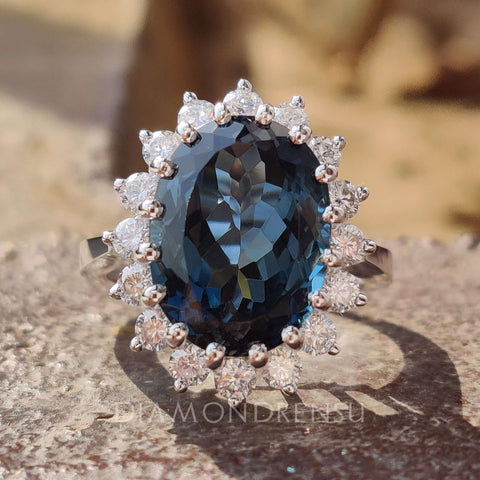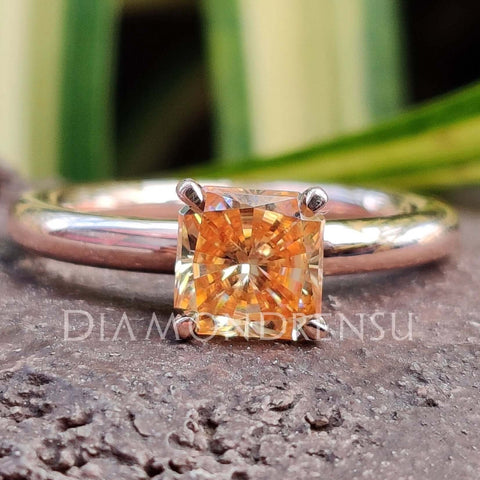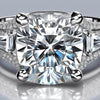
Facts About Moissanite: Unveiling the Gemstone's Unique Qualities
Moissanite, a remarkable gemstone composed of silicon carbide, has been steadily gaining popularity for its beauty and durability. As you delve into the fascinating world of gemstones, you might have come across this synthetic jewel and wondered what sets it apart from its natural counterparts. In the following paragraphs, you will gain an insight into the unique properties.
History and Discovery
In the world of gemstones, moissanite has an interesting and unique background. To understand its history, let's travel back to 1893. During this time, Dr. Henri Moissan, a French chemist, made an intriguing discovery near the Meteor Crater in Arizona. Small, shiny crystals caught his attention, and upon further examination, he realized that they were different from any other minerals he had come across. Dr. Moissan eventually identified these crystals as silicon carbide (SiC), a compound that had never been found in nature before.
For his significant contributions to the field of chemistry, including the discovery of moissanite, Dr. Henri Moissan was awarded the Nobel Prize in Chemistry in 1906. The naturally occurring SiC crystals were then named "moissanite" in his honor. However, despite the initial discovery in Arizona, natural moissanite remains extremely rare.
In recent years, moissanite has been found in other locations around the world, such as North Carolina. Interestingly, these discoveries often involve moissanite inclusions within other minerals, such as in the Ca-Al-silicate inclusions in natural moissanite from kimberlites of Yakutia, Russia. This suggests that moissanite formation occurs under a diverse range of geological conditions, leading to a fascinating story that continues to captivate researchers and gemstone enthusiasts alike.
As you delve deeper into the history and discovery of moissanite, the confident, knowledgeable, and neutral tone of this information will provide you with a solid foundation for understanding the significance of this unique gemstone.
Physical and Optical Properties

When it comes to physical properties, moissanite is incredibly hard, ranking 9.25 on the Mohs scale. This makes it one of the toughest and scratch-resistant materials known, just below diamond, which ranks 10.
Optical properties of moissanite are quite impressive as well. It possesses a high refractive index of 2.65–2.69, which is higher than diamond's 2.42. This means that moissanite displays more fire and brilliance than a diamond, making it eye-catching and stunning. Another desirable optical attribute in moissanite is its dispersion value that is 0.104, higher than diamond's 0.044, which results in increased rainbow-like flashes of light.
One of the most significant features of this gemstone is its superior heat resistance. The reason behind it lies in its thermal conductivity. Moissanite's advanced thermal conductivity allows it to efficiently disperse heat and remain stable even at high temperatures. This property is particularly important for applications in various industries that require materials with high heat resistance.
To summarize, here are the key physical and optical properties of moissanite:
- Hardness: 9.25 on the Mohs scale
- Refractive Index: 2.65-2.69
- Dispersion: 0.104
- Thermal Conductivity: Highly efficient
Considering these remarkable properties, you can see why moissanite is a popular choice for both jewelry and industrial applications. Its durability, brilliance, and heat resistance make it a highly valuable and sought-after material.
Appearance and Variety

Moissanite comes in a variety of colors, shapes, and sizes, making it a versatile choice for jewelry. The most common colors include colorless, yellow, green, blue, pink, and orange. Depending on your personal style and preference, you can find moissanite stones to match any aesthetic.
In terms of shape, moissanite can be cut into various forms like the cushion cut, emerald step cut, and radiant cut. With its high refractive index, moissanite can exhibit exceptional brilliance, fire, and sparkle, which can enhance the appearance of any cut.
When purchasing a moissanite stone, you may also encounter colorless or nearly colorless options. Some people prefer a colorless stone to closely resemble a traditional diamond, while others appreciate the various hues moissanite can provide. As you explore your options, you'll find that there are over 51 different shaped moissanite designs to choose from, ensuring that you can find the perfect stone to match your taste.
In conclusion, moissanite offers a wide range of colors and shapes to suit any style or preference. From vibrant hues to classic, colorless stones, you're sure to find the perfect moissanite piece that complements your personal style.
Comparison with Other Gemstones
| Aspect | Moissanite | Diamond | Sapphire | Emerald |
|---|---|---|---|---|
| Composition | Silicon carbide (SiC) | Carbon (C) | Aluminum oxide (Al2O3) | Beryllium aluminum silicate |
| Hardness (Mohs Scale) | 9.25 | 10 | 9 | 7.5 - 8 |
| Brilliance & Fire | High dispersion and brilliance | Exceptional brilliance and fire | Good brilliance and fire | Moderate brilliance |
| Color Range | Nearly colorless; may have slight yellow or gray hues | Colorless to near-colorless (graded D to Z) | Various colors; blue sapphires are popular | Green to bluish-green; various shades |
| Price | More affordable than diamonds | Varies greatly based on diamond quality | Varies based on size and quality | Varies based on size, quality, and type |
When choosing a gemstone for jewelry, you may come across moissanite, a popular diamond alternative. Let's compare moissanite with other gemstones, such as natural diamonds, cubic zirconia, and sapphires.
- Moissanite vs. Natural Diamonds: Moissanite is a lab-grown gemstone created from silicon carbide; its appearance and properties closely resemble those of a diamond. Although having less hardness than diamonds, moissanite is still almost as durable, making it a suitable option for everyday wear. In terms of brilliance, moissanite outperforms diamonds, as it has more fire and dispersion, creating a stunning sparkle effect. Furthermore, moissanite is considerably more affordable, making it an attractive choice if you're seeking a cost-effective diamond substitute.
- Moissanite vs. Cubic Zirconia: Cubic zirconia is another popular diamond alternative; however, when compared to moissanite, it falls short in several aspects. Moissanite is harder and more durable than cubic zirconia, ensuring longevity and resistance to scratches. In terms of brilliance and fire, moissanite also surpasses cubic zirconia, offering an unmatched sparkle. Lastly, moissanite is more resistant to dirt and oils, meaning your gemstone will require less frequent cleaning.
- Moissanite vs. Sapphires: Sapphires are a beloved gemstone choice, known for their striking color and regal appeal. But, when considering their practicality for daily wear, moissanite has the edge. Moissanite has a higher hardness value than sapphires, making it more resistant to scratches and wear. Moreover, moissanite's superior sparkle and fire give it an unparalleled brilliance compared to sapphires. However, if you're drawn to colored gemstones, sapphires remain an excellent choice for their captivating hues.
In summary, moissanite proves to be a worthy contender among popular gemstones, offering durability, brilliance, and affordability. It stands up well against natural diamonds, cubic zirconia, and sapphires while providing its unique advantages. When selecting your next piece of jewelry, remember to consider moissanite for its impressive combination of beauty and performance.
Moissanite in Jewelry
Moissanite is a popular choice in jewelry, especially as an alternative to diamonds in engagement rings. It is a precious jewel made of silicon carbide and can be found in various shapes, like round, princess, oval, emerald, Asscher, and cushion cuts. You can discover a beautiful selection of moissanite engagement rings that cater to different tastes and preferences.
This gemstone has gained popularity in recent years due to its affordability, durability, and remarkable similarity to diamonds. When it comes to engagement rings, many couples opt for moissanite as a budget-friendly yet stunning choice. In addition to engagement rings, moissanite is also used in other types of jewelry, such as mens moissanite wedding bands, moissanite eternity bands, and vintage style engagement rings.
In comparison to diamonds, moissanite possesses a higher dispersion rate, making it even more fiery and brilliant. This attribute makes it an attractive center stone in antique and fancy-cut engagement rings. When it comes to hardness, moissanite is slightly softer than diamonds, with a rating of 9.25 on the Mohs scale. However, this difference is hardly noticeable and doesn't affect its durability in daily wear.
In summary, moissanite is an excellent option for various types of jewelry, including engagement rings, wedding bands, and vintage styles. Its affordability, durability, and brilliance make it a sought-after choice for those looking for a stunning, yet cost-effective, alternative to diamonds.
Manufacturing and Availability
Moissanite is a rare gemstone, both in its natural occurrence and availability on the market. Originally discovered in 1893 in a meteorite deposit in the form of microscopic crystals, natural moissanite is very scarce and can be occasionally found in lamproite deposits.
Due to its rarity, the widespread use of moissanite in the jewelry industry relies on lab-created or lab-grown methods. The techniques for growing moissanite crystals have been developed and refined over the past decades, resulting in high-quality synthetic moissanite that can rival the brilliance and durability of diamonds. This lab-created approach not only increases the availability of moissanite for various applications but also offers an ethically conscious and environmentally friendly alternative to mined gemstones.
When considering the availability of moissanite, it's crucial to understand that the production process can impact its accessibility. The supply chain for lab-grown moissanite comprises manufacturers that specialize in producing these gemstones, as well as distributors and retailers who focus on marketing and selling them to consumers.
As you explore moissanite, keep in mind the various factors that contribute to its availability, such as the rarity of its natural form, the lab-created manufacturing process, and the network of suppliers that distribute these gemstones. By understanding these aspects, you'll be better equipped to make an informed decision when considering moissanite for your jewelry collection or other applications.
Moissanite Vs Diamond

Let's compare moissanite and diamond and help you understand the differences between these two gemstones. Moissanite is a popular diamond alternative that stands out for its durability, brilliance, and affordability.
In terms of hardness, moissanite has a rating of 9.25 on the Mohs hardness scale, which is very close to the natural diamond's score of 10. This means that moissanite is a very durable gemstone, perfect for everyday wear and extended usage.
The refractive index is useful for understanding the brilliance of a gemstone. With a refractive index of 2.65-2.69, moissanite is significantly more brilliant than diamonds, which possess a refractive index of 2.42. Consequently, your moissanite jewelry will sparkle more than its diamond counterpart.
Despite their similarities, there are some distinctions between moissanite and natural diamonds. For one, the chemical formula of moissanite is SiC (silicon carbide), whereas diamonds are composed entirely of carbon.
It's important not to confuse moissanite with cubic zirconia, another popular diamond alternative. Although both are used as diamond substitutes, moissanite boasts superior hardness and brilliance compared to cubic zirconia, which has a hardness of just 8 on the Mohs scale.
Finally, you might be curious about the relationship between moissanite and inclusions in diamonds. While diamonds often contain inclusions that help determine their quality and origin, moissanite gemstones are typically lab-grown and usually have no inclusions, resulting in a more flawless appearance.
In summary, moissanite is an attractive diamond alternative that offers durability and brilliance at a more affordable price. Make an informed decision when choosing a gemstone for your jewelry, and remember that both moissanite and natural diamonds have their unique characteristics and appeals.
Value and Pricing
When you're considering a diamond alternative, one of the key factors to weigh is the value and pricing of the stone. Moissanite holds a significant advantage in this area, as it typically costs only 5-10% of the average retail price of a comparable diamond. This makes it a more affordable option for your jewelry needs.
Aside from being cost-effective, moissanite is a conflict-free alternative, as it's lab-created rather than mined from the earth. This ensures that your purchase supports ethical and environmentally-friendly practices. When comparing moissanite to other diamond alternatives, you'll find that it boasts similar durability and brilliance, providing an attractive and sustainable option for your jewelry collection.
In determining the value of moissanite, it's important to consider factors such as:
- Carat Weight: Like diamonds, moissanite is priced according to weight. Larger stones will command a higher price.
- Shape and Cut: The complexity and precision of the cut will affect the stone's price. Highly skilled artisans are required to cut moissanite stones to the highest standards.
- Clarity and Color: Moissanite stones are known for their near-colorless to faint yellow appearance and are graded on a similar scale to diamonds. A stone with fewer inclusions and a more desirable color will be priced higher.
Remember, when selecting a moissanite stone, it's crucial to balance the various factors of value, cost, and personal preferences. By doing so, you can ensure that you're making a confident, knowledgeable, and clear decision when choosing this dazzling diamond alternative.
Care and Cleaning

Moissanite is a durable gemstone, making it a popular choice for many. However, to maintain its brilliance, it is essential to clean it regularly. In this section, you'll learn how to care for and clean your moissanite jewelry.
Over time, your moissanite ring or other jewelry pieces can accumulate dirt, grime, and oils from your skin. This buildup can affect the sparkle and radiance of the stone. To keep your moissanite looking its best, you should clean it every few weeks.
To clean your moissanite, follow these simple steps:
- Prepare a cleaning solution: Mix mild dish soap with warm water in a small bowl. Avoid using harsh chemicals or abrasives, as they may damage the metal setting of your jewelry.
- Soak the jewelry: Place your moissanite piece in the cleaning solution and let it soak for 10-15 minutes. This will help loosen any dirt or grime on the stone.
- Brush gently: Using a soft toothbrush or a jewelry brush, gently scrub the moissanite and the metal setting. Pay extra attention to areas that come into contact with the skin, as they tend to accumulate more dirt and grime.
- Rinse thoroughly: Rinse your jewelry under lukewarm water to remove any soap residue. Make sure to close the sink drain or place a strainer to avoid accidentally losing your jewelry.
- Dry and polish: Pat your moissanite dry with a soft, lint-free cloth. Gently polish the stone and the metal setting to restore its shine.
In addition to regular cleaning, it's essential to care for your moissanite jewelry in other ways. Always remove your jewelry when engaging in activities that could expose it to harsh chemicals or physical stress, such as swimming, gardening, or playing sports. Store your moissanite pieces separately from other jewelry to prevent scratches or damage.
By following these care and cleaning tips, you can ensure that your moissanite jewelry remains beautiful and brilliant for years to come.
Frequently Asked Questions
What sets moissanite apart from diamonds?
Moissanite is a gemstone that resembles a diamond in appearance, but it is distinct in many ways. One of the key differences between moissanite and diamonds is their composition. While diamonds are made of carbon, moissanites are made of silicon carbide. This results in slightly different properties, such as a higher dispersion or "fire," making moissanite more colorful and sparkly under light. In addition, moissanite is generally more affordable than diamonds, making it an attractive option for those seeking a budget-friendly alternative.
Where does moissanite originally come from?
The first natural moissanite was discovered in 1893 by French scientist Henri Moissan in a meteor crater in Arizona (source). He initially thought it was diamond, but later identified it as a new mineral, silicon carbide. Natural moissanite is extremely rare on Earth, and most of the moissanite used in jewelry today is lab-created.
Are moissanite stones sourced from meteors?
While the first discovered moissanite came from a meteor crater, most moissanite stones used in jewelry today are not sourced from meteorites. Instead, they are synthetically created in labs to mimic the properties of natural moissanite, making it more accessible for use in jewelry and other applications.
What is the rarity of natural moissanite?
Natural moissanite is extremely rare, with only a few known occurrences on Earth. Most of the moissanite available in the market is lab-created, as it is difficult to find and extract sufficient quantities of natural moissanite for commercial use.
Are moissanite stones more uncommon than diamonds?
Yes, natural moissanite is significantly rarer than diamonds. However, when referring to the stones used in jewelry, lab-created moissanite is widely available and more affordable than diamonds, making it a popular alternative for those seeking a similar aesthetic and lower price point.
What are the advantages and disadvantages of choosing moissanite?
There are several advantages to choosing moissanite over diamonds, such as its lower price, higher fire and sparkle, and ethical sourcing due to its lab-created origin. However, there are also some disadvantages. Moissanite is slightly less durable than diamonds, with a hardness of 9.25 on the Mohs scale compared to a diamond's 10. Additionally, moissanite may not have the same cachet and prestige as natural diamonds, which can be a consideration for those choosing an engagement ring or special piece of jewelry.
Checkout some of our top collections:
Leave a comment
Please note, comments must be approved before they are published.













